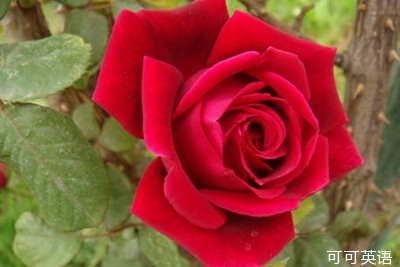玫瑰不叫玫瑰
Just saying the word “rose” conjures up images of romance, secret admirers, Valentines gifts, and bridal bouquets.
“玫瑰”很容易讓人聯想到浪漫的場景,神秘的愛慕者,情人節的禮物和結婚的花束。
Romantics imagine soft, red petals and long, graceful stems, but practical gardeners know all about painful, pointy thorns.
浪漫的人會想象出柔軟的、紅色的花瓣和修長的,優雅的花莖,但是實際上園丁們才知道那些尖銳的刺帶來的痛楚。
As the saying goes, every rose has its thorn.
常言道,每朵玫瑰都有刺。
 But, what we call thorns are actually not thorns at all.
But, what we call thorns are actually not thorns at all.
但是,我們所說的這種刺其實根本就不是刺。
Thorns, like those found on the Hawthorn tree, are modified branches that project from the stem and branches of a woody plant.
刺,例如山楂樹上的刺,實際上是一種改良的分枝,它會從木本植物的莖和分枝中生長出來。
They are very sharp and quite strong because they are made of the same stuff as the stem of the tree or bush.
它們非常鋒利并且相當堅硬,因為它們的質地與灌木或樹的莖是一樣的。
Thorns are deeply embedded in the woody structure of the plant and can't be broken off easily.
這些刺都深深地嵌在植物的木紋狀組織結構內,不會被輕易破壞。
Those nasty points on the stem of the rose are not true thorns: they are what scientists call “prickles.”
這些令人討厭的長在玫瑰莖上的刺其實并不是真正的刺,科學家們稱它們為“皮刺”。
Prickles are smaller than thorns: they are sharp outgrowths of the plant's outer layers, the skin-like epidermis, and the sub-epidermal layer just beneath it.
皮刺比刺要小了許多:它們是這些植物外層的附屬物,看上去像皮膚的表皮,其下還有亞表皮層。
Unlike a thorn, a prickle can be easily broken off the plant because it is really a feature of the outer layers rather than part of the wood, like a thorn.
不像刺,皮刺能夠被輕易地從植物莖上剝落,因為它僅僅是植物外層的一種特征,而不像刺那樣是莖的一部分。
Both prickles and thorns protect the plant from predators, and, maybe, from lovers looking for a free bouquet.
不管是刺抑或荊棘,都可以保護這些植物不被捕食者所獵食,同樣,或許也能免于被那些尋找免費花束的情人所折斷。
But perhaps we call the rose prickles “thorns” because saying “every rose has its prickle” doesn't seem to do justice to the pain of unrequited love.
但是或許,我們應該叫這些皮刺為“刺”,因為“每一朵玫瑰都有它的刺”的說法似乎對那些暗戀者所感受的痛苦來說不太公平。
 But, what we call thorns are actually not thorns at all.
But, what we call thorns are actually not thorns at all.










